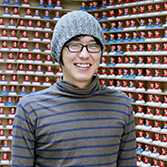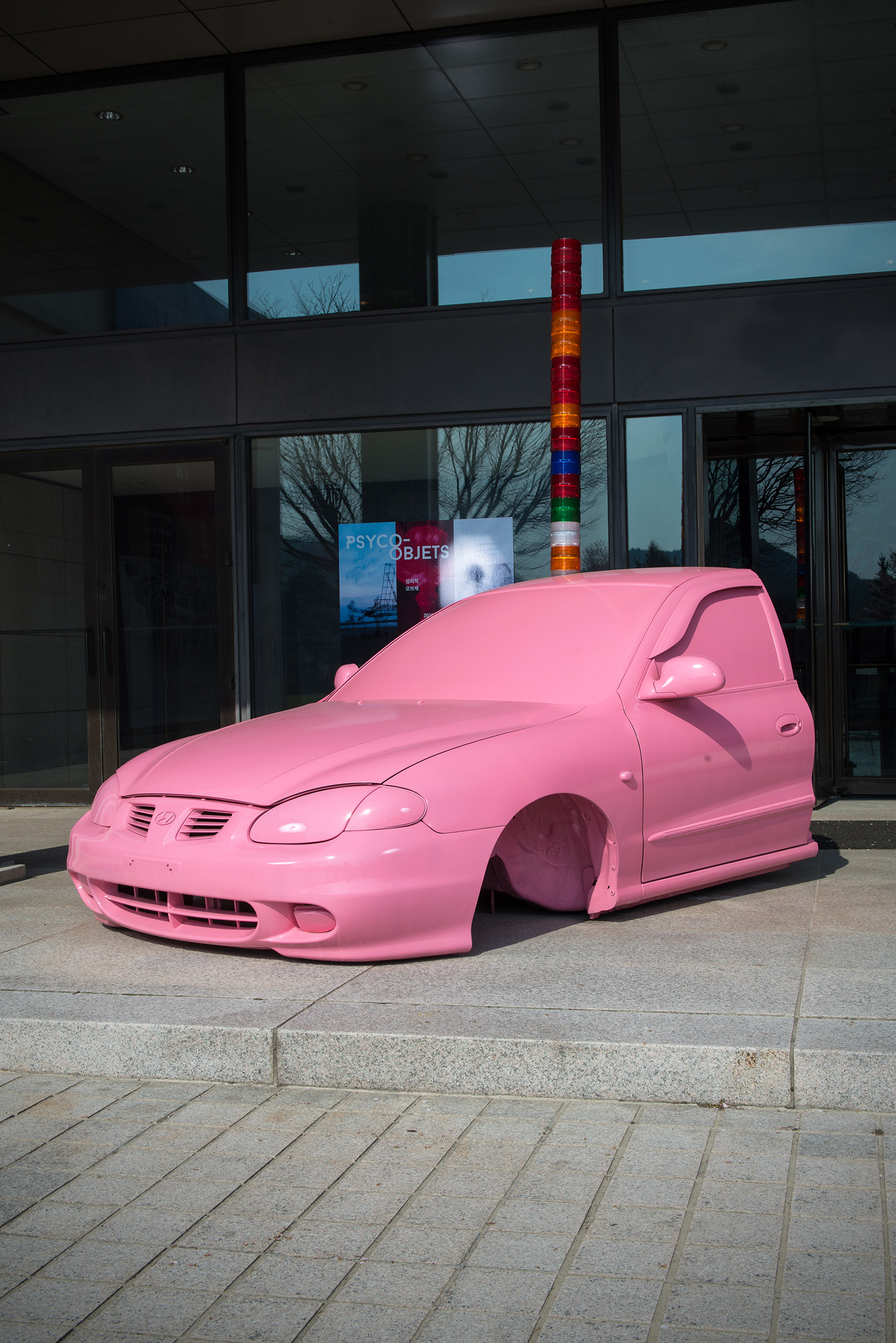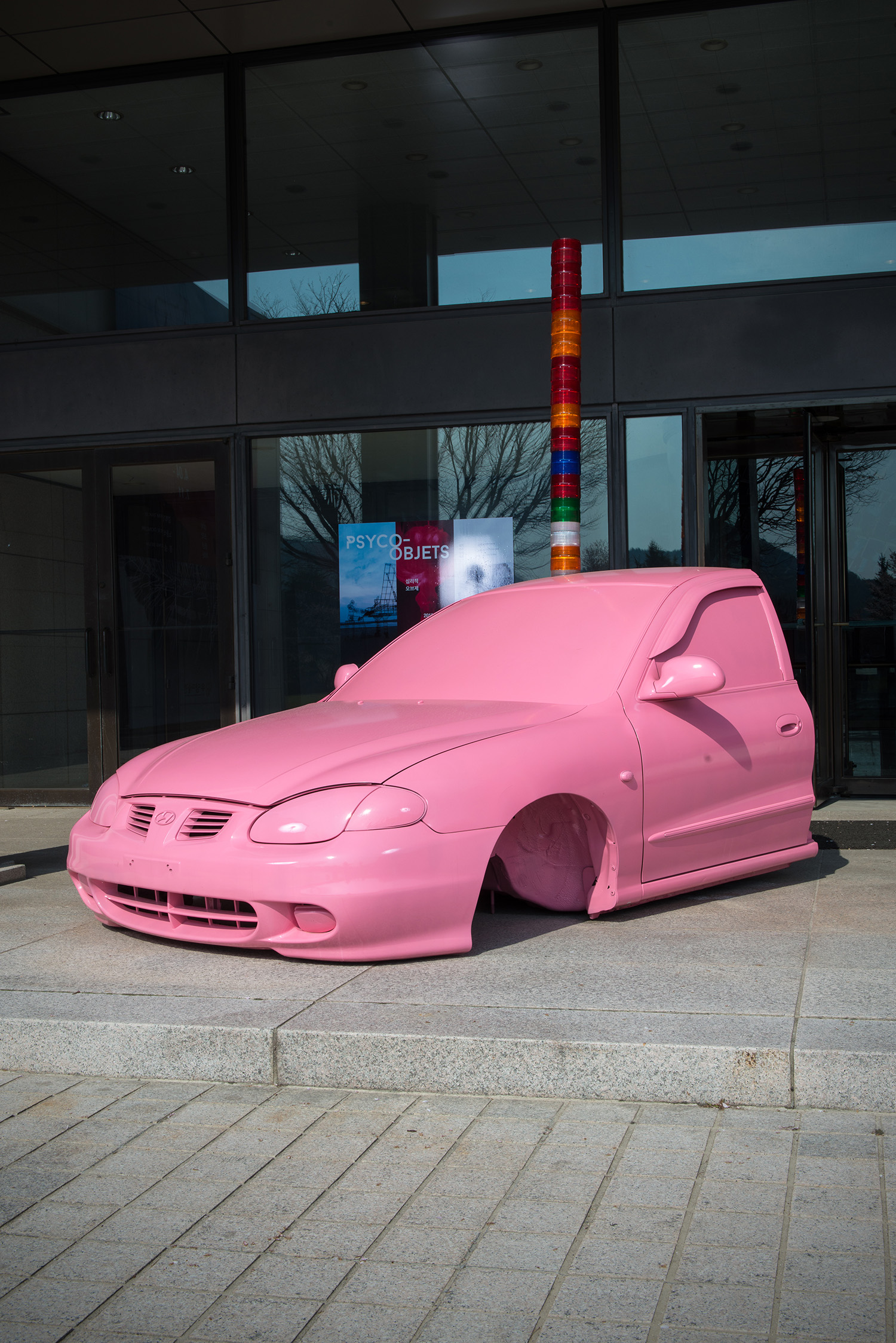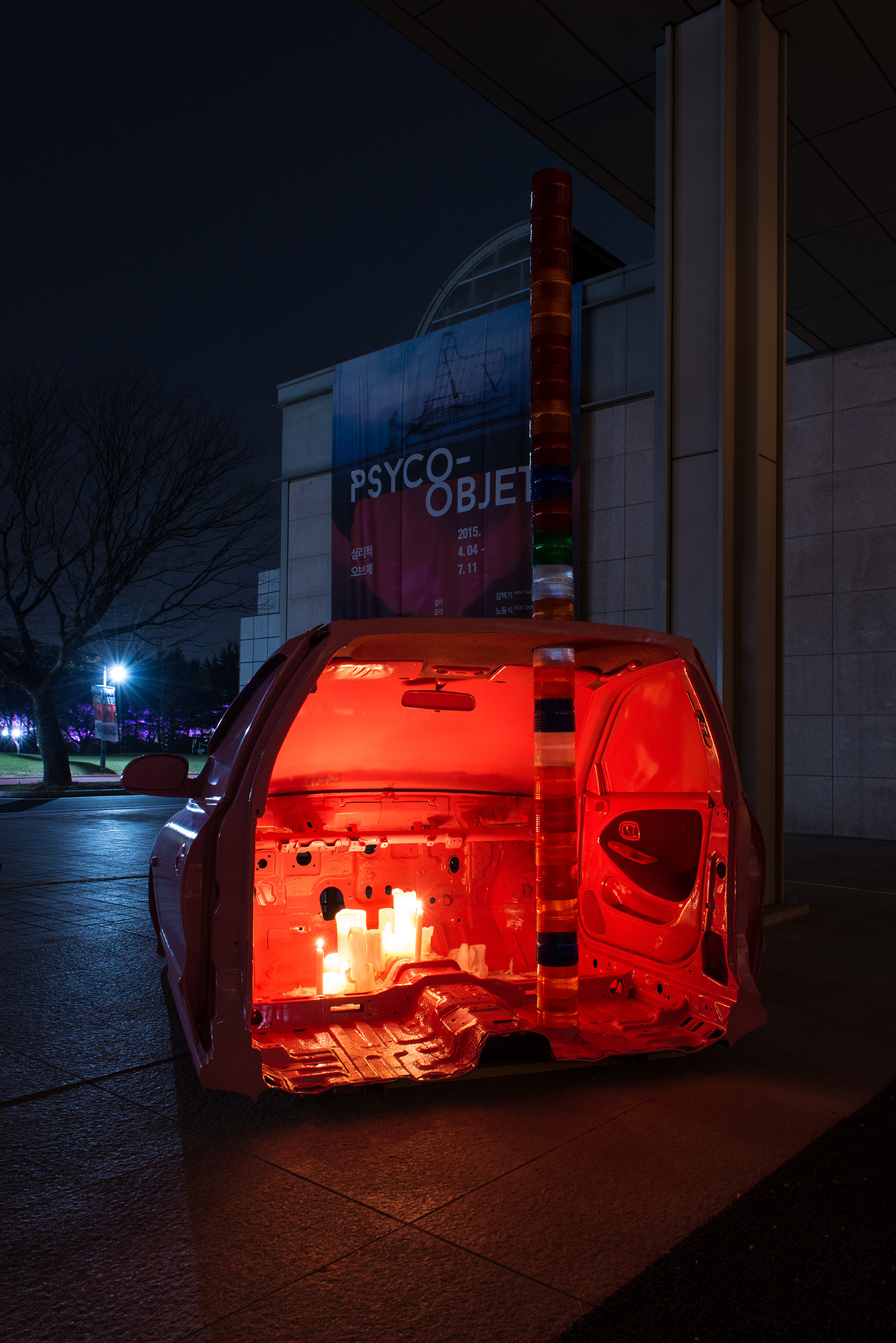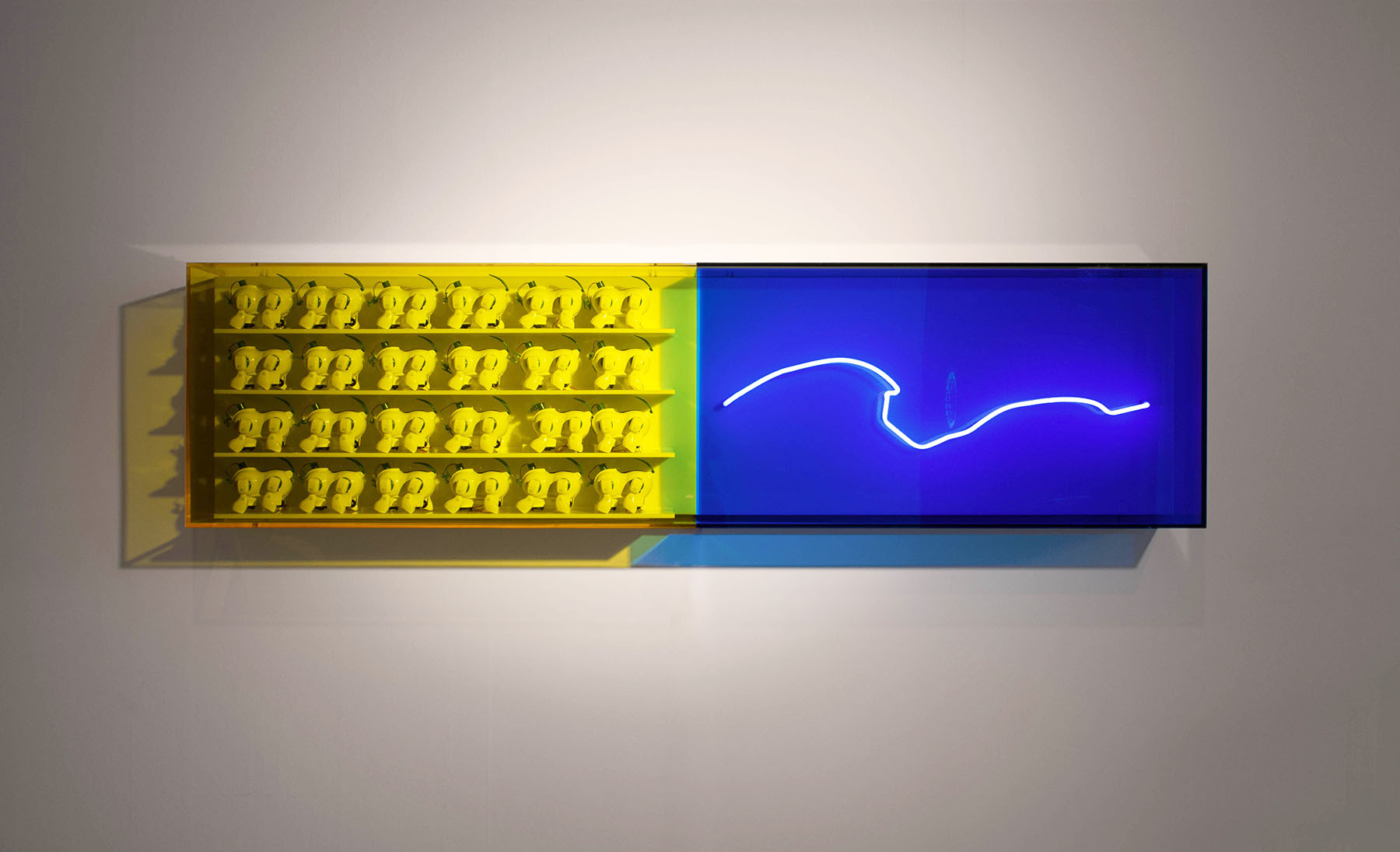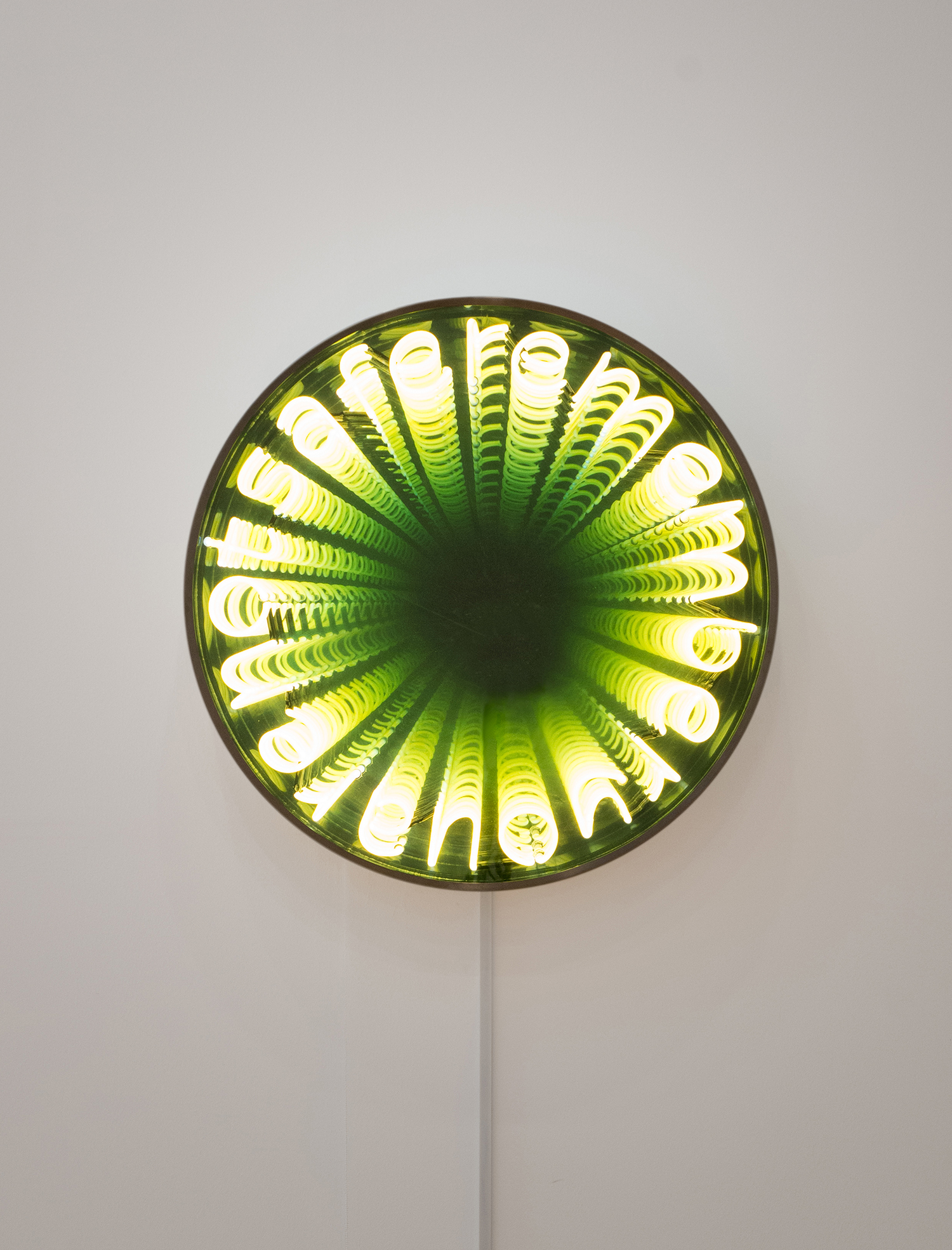Emergence from the Tank: Seung Jung's Evolution of Machines - part 1
Humans would like to believe that we have very little in common with goldfish. Physically, intellectually and emotionally, it should be difficult to draw many legitimate comparisons. Yet it is said that given the opportunity, a goldfish will eat itself to death in a single sitting. With the recent collapse of several seemingly indestructible financial institutions and a global recession now almost a year old, our species must begrudgingly acknowledge that we also have a problem with consumption.
Seung Jung's timely sculptural installation Evolution of Machines - part 1, is a dishearteningly accurate illustration of our collective predisposition to consume. The focal point of the exhibition is a work entitled Robotic Irony, which is comprised of two vacuum cleaners who are each simultaneously ingesting and expelling countless scraps of paper strewn about the gallery floor. This penchant for consumption is far from a recent evolutionary development in humans and has been cleverly depicted by artists for centuries, such as in The Land of Cockaigne, 1567, where Peter Bruegel the Elder portrayed two gluttons in the mythical land of decadence, sprawled beneath a table littered with scraps of meats, cheeses, pastries and wine after a feast of epic proportions (their poses, ironically, similar to that of dead goldfish). The consumerist critique has continued in contemporary art as well, examples of which include the playfully subversive figurative works of Tom Otterness and the meticulous collages made from currency by Mark Wagner. However Seung Jung has advanced this discussion in the artistic realm by creating a kinetic entity that mimics our constant consumption in an exaggerated, yet unequivocally humanist manner.
From a technical standpoint, Robotic Irony is a remarkable step in the artist's oeuvre, which in recent years has consisted primarily of cleverly manipulated objects and machines into which Jung infuses human and animal characteristics. In Stands, 2006, the artist deconstructed massive shelving units and transformed the top sections of each into tentacle-like extremities that dramatically reached into the corners of the gallery space. In 2008 Jung completed a series of works in which he affixed thousands of plastic fasteners to a myriad of inanimate objects such as cars, copiers and lawn chairs, adding a dynamic element that gave the impression the object was caught committing a human act. This notion was most evident in A Struggle for Evolution, 2008, one of Jung's most successful, yet simple works in which one industrial fan is wrapped around another in an emotional embrace. However Robotic Irony represents the first time the artist has altered the intricate inner workings of an apparatus as opposed to just the exterior, visual attributes. Thus, these works do much more than resemble the appearance of a human being; they simulate characteristic actions. This an ambitious step in Jung's career, not only because it required the assistance of several engineers, but because the analogy is so much more significant. For example, would one prefer to be told they look like a goldfish, or act like a goldfish?
In all of Seung Jung's work, in addition such dark elements as voyeurism, confinement and physical deterioration, there also exists a refreshing sense of humor that could too easily be dismissed by some of the more demure sects of the art world public. A feeling of whimsy can be found in Robotic Irony as well, in its mocking impression of human beings systematically devouring fragments of sustenance without any regard for substance. However this characterization is certainly more condemning than it is joking, and undoubtedly Jung's most overt cultural criticism to date.
The most specific aspect of this criticism lies in the scraps of papers constantly being devoured and excreted in Robotic Irony, which are culled from a combination of glossy pop culture and glamour magazines, newspaper text and imitation currency. Each of these elements are perpetually consumed by contemporary society as well, but ultimately unnecessary in terms of basic survival. By choosing not to replace these fragments throughout the course of the installation and thereby encouraging their distortion and disfiguration, Jung emphasizes the indistinguishable nature of material objects and the absurdity of our continued quest to consume them.
The apocalyptic rate at which hundreds of millions of humans had been spending money they had not earned on unnecessary material goods they did not need seems to have slowed in the last year, though it took a worldwide economic collapse. In this visually and technically innovative installation, Seung Jung manifests the irrational nature of the behavior that led to this watershed moment. While our continued existence suggests we have avoided the goldfish comparison for the time being, the title of this exhibition, Evolution of Machines - part 1, reminds us that our maturation has (hopefully) just begun.
Eric Gleason
JUNG,Seung review
A cable tie cannot be untied once it’s fastened; it has to be cut. For Seung Jung, a cable tie is a symbol of mechanical civilization. Jung’s works demonstrate the absurdity of progress or historicism which chooses to doggedly follow the path of improving productivity. The irreversibility of time which is inherent to linear evolution implies violence. Jung transforms sleek machines, like a car or a photocopier, into barbaric objects by covering them in cable ties. The joint evolution of machines and humans is a reflection of humans themselves. Machines and humans are connected, and together, they become a single “desiring machine.” The artist sees a “struggle for evolution” in his piece consisting of two electric fans joined face-to-face, connected and distorted without reason. The process by which things are divided by their function and then re-united marks the evolution of capital for profit. In one of Jung’s early works, he completely dismantled a car, the pinnacle of cutting-edge technology. He completely tore out the insides of the car, leaving only the frame, which resembled a grotesque spider. Notably, in order to get approval for this work, he had to submit to a byzantine process seeking the permission of everyone from a school guard to the mayor. This experience exemplifies the predominance of bureaucracy, which repetitively expands without any clear reason or goal. In Multi Complex (2009), Jung connected hundreds of multi-outlet sockets together to run a simple electric device, thus representing the meaningless sprawl of a system. Leaving behind functionality, such systems operate only to ensure their own survival.
Jung locates “the evolution of a machine” in a vacuum-cleaning robot that endlessly sucks up and expels printouts that are scattered all over the floor. Consumption and production are nothing but an infinitely repeating system of making garbage out of garbage. Criticism of a contemporary society is inherent in such realization, but since humans themselves are a by-product of this system, it’s not clear who is a victim and who is a perpetrator. Circling Complex (2010) involves 200 matching toys of a headless, armless bike rider perpetually circling around a small track. The piece illustrates people’s contemporary daily life cycle, which tends to orbit around a set path or routine. Jung discovered the toys one day while he was hurriedly walking through the subway, on his way somewhere, and he felt that they represented the contemporary way of life, which is impelled on people by an invisible system. Circles often appear in his works as symbols of a repeating system. More recently, he used another toy attached to a round fluorescent light to present an atmosphere somewhat like a mandala. His works show how the respective systems of contemporary society, machines, religion, and art overlap with each other. The systems are linked, producing a power capable of governing not only a human body, but also one’s consciousness and unconsciousness. His Spectacleless Complex (2011) comprises two thousand identical Chinese imitations of a Japanese toy, arrayed like spectators in a stadium. Using the surrounding light as their energy source, they sway as if they are alive, until eventually they fall to the ground, one by one. In a society of spectacle, only falls like this attract people’s attention. For Seung Jung, the typical contemporary individual is a clone, a disposable entity who accidentally disappears after spending a given amount of time repeating the same programmed behaviors.
Sun-Young Lee
Seung JUNG: Idea of Complex_ Rhetoric of numerous and repetition
Objects themselves are things strictly halted, with no room for questions. The functions and roles of such objects are identified according to the location and position as defined with the 'constructed meaning system' as developed by humans. Even still, objects as objects fundamentally exist outside of the organic meaning system we have created, they also become unfamiliar subjects with doubtful origins. In other words, such objects are objects which we recognize from only within the context in which we name them. Such a point is relevant in industrial products we mass-produce. Industrial objects, which start to exist in identical forms through mass production, acquire meaning within certain places for certain functions, yet they become incomprehensible once removed from their intended position. Seung JUNG uses industrial objects produced in mass. The large quantity and identicalness of such objects makes them gradually seem more separated from their production method or production relationship. The 'unfamiliarity' evoked by industrial objects of today is different from the semi-industrial objects as experienced by Duchamp in the early 20th century. Within 'German Ideology', Marx discussed, as mentioned below, about what types of change mass production has brought for production relationships and relationships of humans and subjects.
The worker becomes all the poorer the more wealth he produces, the more his production increases in power and range. The worker becomes an ever cheaper commodity the more commodities he creates. With the increasing value of the world of things proceeds in direct proportion to the devaluation of the world of men.
(...) Such truths are not simply the subject which labour produces - the commodities of labour - but as one unfamiliar existence, expresses the separation from labour. Labour does not only create goods; it also produces itself and the worker as a commodity, and indeed in the same proportion as it produces goods. Political economy thus does not recognize the unoccupied worker, the working man so far as he is outside this work relationship. The yare ghostly figures outside the domain of political economy.
If labour is a specific process to which a meaning possible for humans to recognize is given, then the objectification of labour is suggestive of a transferring to a system of an independent derealization of such a meaning. The objectification of labour as asserted by Marx is displayed in today's art in two forms. One is the 'Derealization of the artistic meaning system'. The other, same as the existential mode of capitalism based on neo-liberalism representing 'Empire', is the creation of an independent and self-guided 'artistic circulatory system'. Borrowing from the expression of Marx, such can be seen to bring about alienation between the artist and artwork or estrangement between the artist and audience. In another way, such also works to guarantee the continuous excitement for art and its large-sized network, similar to capitalism.
There are two elements in the works in what Seung JUNG refers to as 'complex': one is 'numerous', which involves the tragic fate of production through the repetition and objectification of identical things. The other is 'repetition', and rather than being simple arrangements, they represent a type of cannibalism of self through self instruction and mindless repetition. 'Circling Complex' is a surprising work which elicits a blind and circulatory race by cycler dolls. The extreme catharsis felt when the approximately 200 bicycles cycle around in their original places making large noises and then abruptly stop is a feeling experienced in no other type of work. 'Multi Complex' the work comprised of numerous multi taps look as like millipeds connected together at the joints hanging in the empty sky. Multi taps with red switches at the end look like congested veins of an erected genitalia. The small fan connected from them with a plug elicits the feeling of a small, dying animal with its head towards the ground and squirming. Such a scene is more tragic than any final scene acted by any actor.
'High Voltage Complex', an oil painting, is a description of the electric stimulus connected to the brain or the objects which comes to our mind. The brain, which requires high pressure voltage, is suggestive of a derealized brain requiring endless stimulation and excitement, much like capitalism or the autonomous circulatory system as found in art. The brain of an artist is no exception. Through the excessive repetition and self instruction of Seung JUNG, he brings forth a base of objectification of spectacles by creating still moments of time. Such is the highlight of the poetic qualities possessed by Seung JUNG. Spectacles, themselves, make such still moments more effective and powerful.
If we connect back with the works of Seung JUNG, we could use the following story: that is that an industrial product per is the object which decides the industrial production relationship. Such, at the same time, is strictly unfamiliar. That is also the reason why Ready-made and Objet were brought to the center of artistic discussion during the 20th century. Consequently, excessive poetic emotions can inadvertently transform these objects into a center of sentimentality. In other words, the object is transformed into the understood product. The artworks of Seung JUNG stands precisely on those boundaries. In the way that the subject objectifies labor, the objectification of the subject strictly from art will continue to persist as a problem. The perception of a subject exists with our eyes. As a result, the task always before us to get over such a perception to recognize it as a problem.
Yoo Jin Sang (professor of Kaywon School of Art & Design)
Mutant Machines and their Self-destructive Impulse
A copy machine operates in the corner of the exhibit room. It is working even though its interior parts are exposed, emitting light and incessantly scanning. Its inner parts are spilled out like internal organs and are painted red, blue, and yellow. This broken machine is put together again using cable ties that are woven together densely like hairs on an animal. The cable ties appear to be desperately trying to hold together the machine’s body. Jung’s work, 'An Optical Illusion of Contemporary People in Three Primary Colors', was conceived from the three colors of ink found in a copy machine. A vast number of colors can be formed by the combination of these three colors. This creates a situation where an extremely small number of codes become the sole standard of operation. In this sense, the diversity of the world is restricted by specific patterns of combination and their infinite reproductions.
The cable ties holding together the pieces of the broken machine are able to be easily tightened, but only in one direction. Effectively, they can only be used once. The cable ties Seung JUNG has frequently used are not merely for the purposes of presenting an interesting form, but also serve to condense some of the essential aspects of contemporary civilization through their characteristics of convenience, disposability, tightness, and linearity.
In the age of convergence, when separate objects are able to be seamlessly put together, Jung joins together fragments like patchwork. He maximizes visible impact by using connecting technology that is usually exploited in the digital sector in large analog machines. The technology that brings together remote objects and condenses them onto the same plane creates new value or new profit. In the case that this compression and synthesis is taken to the extreme, this process reaches a kind of absurd state, which Jung’s tattered machine symbolizes. His machines are in a state where all parts remain equal through a blind fusion that eliminates each part’s true worth and conceals their original function and uniqueness. A huge amount of energy and matter has to be integrated to facilitate this process step by step. These elements are in a state of endless competition in the same plane. This tendency brings about tedium and struggle rather than diversity and peace.
The work 'Flowing Water Returns As a Rain' joins a shower with a toilet whose bottom is broken. Water pours out from these fragments onto a tile floor and circulates by a motor. The muddy water circulating between the shower and the toilet implies the processes of washing and the disposal of excrement. This work might be an imagined product for simultaneous excavation and bathing. The work is aimed at representing contemporary people’s obsession with sanitation through this dual action of washing, which highlights our desire to be constantly getting clean. Therefore, other types of consumption and production can fill the space and time saved by this action. This machine exemplifies when the cycle of production and consumption is so extremely shortened that it becomes inseparable. The piece with two electric fans facing each other maximizes the absurdity of such a fusion. Like its title, it is a struggle for evolution. The two electric fans with conjoined heads and entwined bodies generate a harsh sound and are continuously being twisted. These two intertwined and struggling objects are perhaps more gruesome than even the monsters in our imagination.
In this exhibition, exploiting a copy machine, electric fans, and a toilet bowl, Jung presents the mutant machines that he has experimented with over the past several years. All these hybrid machines have had their original functions modified and changed. In this way, evolution for survival is applied to not only living creatures, but also to machines. These types of experiments about adapting to the environment in nature give birth to both mutants and transient beings.
They again differentiate into a few competitive species. A series of fundamental techniques like cutting and putting pieces together are made in an artistic and scientific laboratory. Any fusion and concentration are usually for the improvement of productivity. A myriad of parts have to be assembled to produce a car or a computer. That is at the same time the concentration of labor and surplus value. In a contemporary capitalistic society a wide variety of motivations and actions concentrate on increasing productivity. All are requested to demand the same thing. Mass production is possible through concentration and fusion while mass consumption demands the standardization of desire. This standardization, however, causes poverty in abundance. A self-destructive impulse is immanent in a rampant fusion to produce more benefits.
Jung’s stitched machines still work but do not perform a normal operation. The machines and tools Jung uses are mostly industrial products faithful to their functions. The shapes of electric fans, a toilet, a shower, and a copy machine are visualized for their original purposes without any decoration. Such mediums for Jung’s work are the results of functionalism which asserts that form follows function and has a preference for function. The combination of functions in reality is for a more enhanced function and that is made by the adjustment of capital and the control of bureaucracy. Seung JUNG’s combination of divided symbols by using cable ties is symbolic of the process of generating profits in industrial sites and markets.
Absurd aspects of experiments conducted by plants and markets to double an object’s function are maximized. The new machines and apparatus Jung conceived show no improvement of any function and productivity but seem to rush toward self-contradiction and self-destruction. His machines that remain deformed in their functions but keep working demonstrate desire itself. Recalling machines and men at the same time, they turn eventually to the machines in desire. Gilles Deleuze says, in his book analyzing capitalistic society, that machines in desire are continuously out of order while operating but work only in this trouble. Their trouble consists of part of their operation. Desire is a machine, a synthesis of machines, and the arrangements of machines.
Any desire belongs to the order of production. All kinds of productions are desiring something and simultaneously social. Modern reason is characterized by its inclination toward unity. In 'Modern Conditions (Conditio Moderna)' Manfred Frank points out that the fundamental traits of human’s rational judgment have become the universality, inevitability, and purposiveness of human thought since Augustine mentioned that human reason is the force toward unity. Reason opposes an individual’s passion to the rationality of general will, incapacitating political, social forms that are not based on any scientific demonstration. As a result, reason has become a basis of universalism and modernity was completed through the control of reason.
Seung JUNG’s absurd machines are another mirror reflecting humans. They are in lack or excess of rationality. They take the same path as modern reason has taken. Reason is not always impartial and transparent but is intertwined with desire and power. In Jung’s work machines are deformed and lost their original functions. In such deformation, however, there is no specific purpose. Like modern art, they have ‘purposiveness without purpose’. They unveil concealed irrationality in capitalistic society where an act of production is not for humans but for production itself. To discover any moment of liberation or oppression in this irrationality depends on the view of the audience.
Lee Sun-young (Art Critic)






